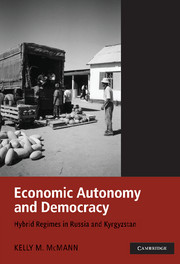Book contents
- Frontmatter
- Contents
- List of Figures
- List of Tables
- Acknowledgments
- Notes on Transliteration
- Economic Autonomy and Democracy
- 1 Capitalism, Democracy, and Economic Autonomy
- 2 The Concept of Economic Autonomy
- 3 Measurement of Democracy
- 4 Activism under the State's Thumb
- 5 Illustrations of Economic Autonomy
- 6 Hybrid Regimes
- Appendix A Description of Surveys
- Appendix B Alternative Explanations
- Appendix C List of Interviews
- Appendix D Measurement of Eight Guarantees of Democracy
- References
- Index
Appendix B - Alternative Explanations
Published online by Cambridge University Press: 01 September 2009
- Frontmatter
- Contents
- List of Figures
- List of Tables
- Acknowledgments
- Notes on Transliteration
- Economic Autonomy and Democracy
- 1 Capitalism, Democracy, and Economic Autonomy
- 2 The Concept of Economic Autonomy
- 3 Measurement of Democracy
- 4 Activism under the State's Thumb
- 5 Illustrations of Economic Autonomy
- 6 Hybrid Regimes
- Appendix A Description of Surveys
- Appendix B Alternative Explanations
- Appendix C List of Interviews
- Appendix D Measurement of Eight Guarantees of Democracy
- References
- Index
Summary
Chapter 2 considers the influence of interests, resources, and organizational capacity relative to economic autonomy. This appendix considers four other alternative explanations – political opportunity structures, institutions, leadership, and international promotion of democracy. Unlike economic autonomy, none account for the greater degree of self-censorship and government harassment in Ul'ianovsk and Naryn.
POLITICAL OPPORTUNITY STRUCTURES
Scholars have argued that political changes, such as increased access to government institutions and new alliances with government officials, can encourage people to become politically involved. Clearly, by harassing activists, local authorities are not sending the message that they want citizens to be involved in politics. Yet, harassment cannot explain self-censorship in Ul'ianovsk and Naryn. As Chapter 4 enumerates, government punishments in Ul'ianovsk are more common than they are in Naryn, yet self-censorship is greater in Naryn. Moreover, government harassment cannot account for the fact that a few individuals in Naryn nonetheless do challenge local authorities.
INSTITUTIONS
Institutions are often cited as possible influences on democratic development in the former Soviet Union. Institutional theories hypothesize that reformers can design laws regulating elections, legislatures, and other components of democracy in order to enhance the long-term success of this form of government. However, laws regulating activism are too similar in the provinces of each country to account for the differences in officials' and activists' behaviors.
- Type
- Chapter
- Information
- Economic Autonomy and DemocracyHybrid Regimes in Russia and Kyrgyzstan, pp. 201 - 217Publisher: Cambridge University PressPrint publication year: 2006

